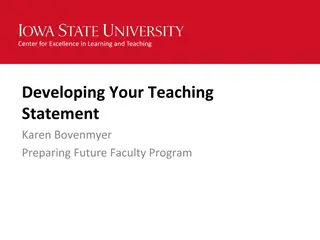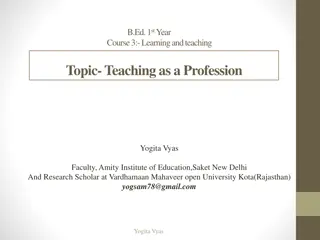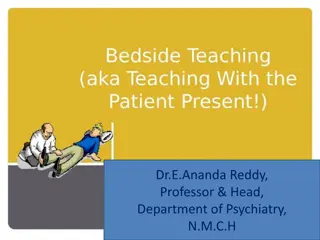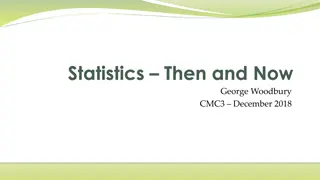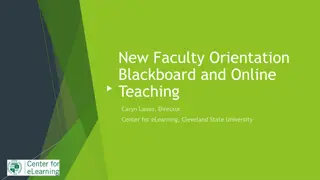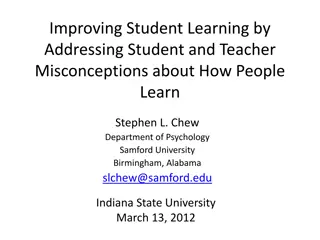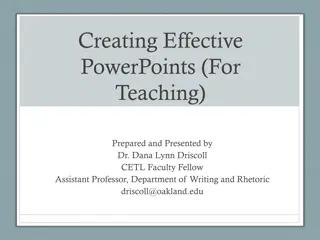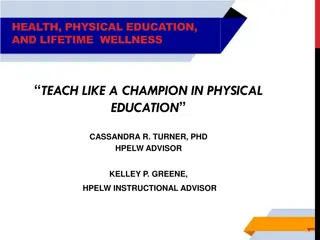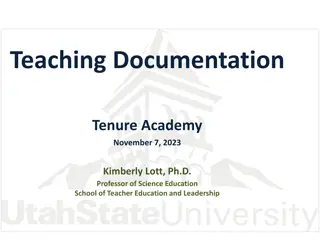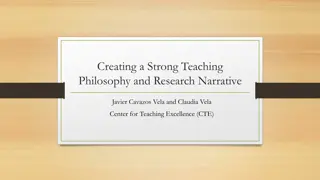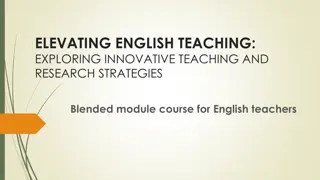Mastering Online Teaching: Strategies and Insights
Discover key insights into teaching online, including faculty attitudes on technology, challenges, time commitments, and best practices for creating a strong online learning community. Learn about the importance of preparation, faculty presence, student connections, and leveraging technology effectively. Gain valuable tips to succeed in the world of online education.
Download Presentation

Please find below an Image/Link to download the presentation.
The content on the website is provided AS IS for your information and personal use only. It may not be sold, licensed, or shared on other websites without obtaining consent from the author. Download presentation by click this link. If you encounter any issues during the download, it is possible that the publisher has removed the file from their server.
E N D
Presentation Transcript
2 Hello! Laura Widenor Instructional Designer K-State Global Campus lwidenor@ksu.edu gcid@ksu.edu
3 2019 Faculty Attitudes on Technology 46% have taught online 41% less than 5 years Skepticism Jaschik, S., & Lederman, D. (2019). 2019 Survey of Faculty Attitudes on Technology: A study by Inside Higher Ed and Gallup(Rep.). Washington, DC: Gallup.
4 Skepticism
5 Teaching online Challenges
6 Time Commitment Time Spent on Online Course Development 1st time 2nd time 3rd time 0% 10% 20% 30% 40% 50% 60% 70% 80% Agree Strongly Agree Freeman, L. A. (2015). Instructor time requirements to develop and teach online
7 Strong preparation leads to smoother implementation 8 to 16 weeks ahead Strong syllabus Well organized consistent course navigation Avoid creating as you teach!
Creating Community Faculty Presence 1. Manage expectations 2. Be Present 3. Frequent but concise 4. Automated feedback with a personal touch 5. Be the facilitator
Creating Community (cont.) Student Connections 1. Design for interaction 2. Tell them the Purpose 3. Spell it out 4. Let students lead
10 Place your screenshot here The Discussion Bored CC licensed by Seth Robbins, BYU Idaho
11 6,657,460 33% of all students who are enrolled take at least one online course
12 Classrooms don t need tech geeks who can teach; we need teaching geeks who can use tech - @DavidGeurin
13 Ways to succeed Quality Support Partner
14 77% Teaching online improves all teaching Engagement Active learning communication
15 No significant difference in outcomes
16 Thanks! Any questions? You can find me at: lwidenor@ksu.edu gcid@ksu.edu
17 REsources Allen, I. E., & Seeman, J. (2013, January). Changing Course, Ten Years of Tracking Online Education. Retrieved December 5, 2017, from http://onlinelearningsurvey.com/reports/changingcourse.pdf Bernard R., Abrami P., Lou Y., Borokhovski E., Wade A., Wozney L., et al. (2004). How does distance education compare to classroom instruction? A meta-analysis of the empirical literature. Review of Educational Research, 74, 379 439. Freeman, L. A. (2015). Instructor time requirements to develop and teach online courses. Online Journal of Distance Learning Administration, 18(1). Retrieved December 05, 2017, from http://www.westga.edu/~distance/ojdla/spring181/freeman181.html Infande, A. (2013, July). A Dozen Strategies for Improving Online Student Retention. Retrieved December 06, 2017, from https://www.facultyfocus.com/articles/online- education/a-dozen-strategies-for-improving-online-student-retention/ Jaschik, S., & Lederman, D. (2019). 2019 Survey of Faculty Attitudes on Technology: A study by Inside Higher Ed and Gallup(Rep.). Washington, DC: Gallup. Kumar, P., & Skrocki, M. (2016, May 6). Ensuring Student Success in Online Courses. Retrieved December 06, 2017, from https://www.facultyfocus.com/articles/online- education/ensuring-student-success-online-courses/ Lederman, D., & McKenzie, L. (2017, October). Faculty Buy-in Builds, Bit by Bit: Survey of Faculty Attitudes on Technology. Retrieved December 08, 2017, from https://www.insidehighered.com/news/survey/faculty-buy-builds-bit-bit-survey- faculty-attitudes-technology Lehmann, K., & Chamberlin, L. (2015, November). Time Management Strategies for Online Instructors. Retrieved December 05, 2017, from https://www2.uwstout.edu/content/profdev/rubrics/time_management.html
18 REsources Morrison, D. (2012). Got Time? A Time Management Strategy for Online Instructors. Retrieved December 05, 2017, from https://onlinelearninginsights.wordpress.com/2012/10/05/got-time-a-time- management-strategy-for-online-instructors/ Ragan, L. (2009, June). 10 Principles of Effective Online Teaching: Best Practices in Distance Education. Retrieved December 06, 2017, from https://www.facultyfocus.com/wp-content/uploads/2015/02/10-Principles-of-Effective- Online-Teaching.pdf Somenarain, L., Akkaraju, S., & Gharbaran, R. (2010, June). Student Perceptions and Learning Outcomes in Asynchronous and Synchronous Online Learning Environments in a Biology Course. MERLOT Journal of Online Learning and Teaching,6(2). Retrieved December 5, 2017, from http://jolt.merlot.org/vol6no2/somenarain_0610.htm Stuart Peery, T., & Streamer Veneruso, S. (2012, March). Managing Instructor Presence and Workload, Boosting Student Engagement. Retrieved December 05, 2017, from http://www.facultyfocus.com/articles/online-education/balancing-act-managing- instructor-presence-and-workload-when-creating-an-interactive-community-of- learners/ Wingo,N. P., Ivankova, N. V., & Moss, J. A. (2017) Faculty perceptions about teaching online: exploring the literature using the technology acceptance model as an organizing framework, Online Learning 21(1), 15-35. DOI: 10.10.24059/olj.v21i1.761 Zhao, Y., Lei, J., Yan, B., Lai, C., & Tan, H. S. (2005). What makes the difference? A practical analysis of research on the effectiveness of distance education. Teachers College Record, 107(8), 1836-1884. DOI: 10.1111/j.1467-9620.2005.00544.x






